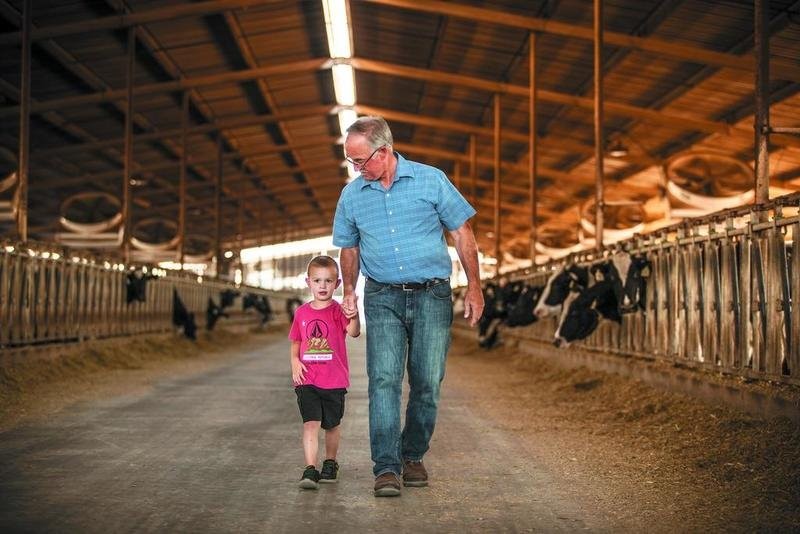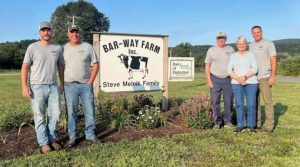
“This is how we’re going to break down the barriers to make technology and best practices more accessible and more affordable to farms of all sizes and locations across the country,” said Krysta Harden, executive vice president, global environmental strategy at Dairy Management Inc.
It won’t be one-size-fits-all solution.
“Every farm is different, so the technologies and farming practices have to be adapted to make sense for every farmer,” Harden said.
The Net Zero Initiative focuses on four key areas:
• Feed production.
• Manure handling and nutrient management.
• Cow care and efficiency.
• On-farm energy efficiency and renewable energy.
The initiative was unveiled by the Innovation Center for U.S. Dairy, which was formed in 2009.
“The Innovation Center was created by DMI at the urging of farmers to bring together a forum of many stakeholders that include retailers, food service companies and nonprofit organizations,” said Mike Haddad, chairman of the Innovation Center for U.S. Dairy. “The group was convened because farmers wanted to be connected to processors, retailers and food service companies that sell milk and milk products.”
“We are building from an initial analysis that indicated net zero is possible on certain farms, and the Net Zero Initiative works to expand that research, knowledge and adoption of practices and technologies that reduce greenhouse gas emissions and impact water,” Harden said. “The initiative is also engaging potential partners and working on farm selection for pilots that represent the regional diversity of dairy.”
The 2050 Environmental Stewardship Goals include: become carbon neutral or better, optimize water use while maximizing recycling and improve water quality by optimizing utilization of manure and nutrients.
In 2008, Harden said, the dairy industry was the first ag sector to commission a life cycle assessment for fluid milk.
“That showed dairy accounts for 2% of the total greenhouse gas emissions in the U.S.,” Harden said.
“The environmental impact of producing a gallon of milk today is 31% less water, 21% less land, 21% less manure and 20% smaller carbon footprint than 2007,” she said.
“Cows as ruminants are kind of a miracle because they can convert by-products into nature’s most perfect food,” said Steve Maddox, a California dairyman and vice chairman of Dairy Management Inc. “I’ve fed a lot of things over the years and currently over 50% of the cows’ feed ration is by-products that if we weren’t feeding to cows would end up in landfills.”
Maddox has fed products that include bakery waste, Doritos and sunflower meal.
“In California we have 400 different crops and every one can be fed at some level to cattle,” he said.
The Maddox family has been open to doing research on their dairy farm for many years.
“My dad graduated from college in the ‘50s, so we’ve done studies and trials,” he said.
In addition, over the last 50 years, the dairymen have hosted 250 foreign trainees and over 150 college interns to learn about the operation.
“When you have to teach others, you learn what you’re doing better, or if you can’t explain it, you make changes,” Maddox said.
“We use virtually no purchased fertilizers to grow our 1,600 acres of corn for silage and we have subsurface drip in our alfalfa fields that saves 25% of the water,” Maddox said. “We use biological pest controls, and we have several areas for wildlife.”
Maddox is experimenting with facial ID with his cows to evaluate their needs.
“For genetics our in vitro fertilization lab, there are 6,000 embryos produced per year to maximize feed efficient cows and positive health traits to keep the cows healthier,” Maddox said.
“I live by the dairy and so do my grandkids, so I breathe the same air and drink the same water, which means long-term sustainability is important,” he said. “Also financial stability because it’s hard to be green when you’re in the red, so all these sustainability practices need to have a bottom-line impact.”
Nestle has committed $10 million to support the Net Zero Initiative.
“Nestle is the first legacy partner with us to help transform dairy for the future,” Harden said. “They are going to support research, on-farm pilots and help us to develop new markets, and we look forward to bringing other partners on board.”
Harden is expecting 2021 to be a very busy year.
“We hope to identify key farm pilots and focus on scaling up adoption across the industry so we can accelerate progress over time towards the 2050 goals,” she said. “The practices and technologies needed to reach these goals largely exist today, but they do require further development, operational improvements, changes and advanced technical assistance.”
There is work to be done and more investment is required, Harden said.
“One of the greatest barriers for adoption is the investment required by farmers,” she said. “We believe new products can generate new revenue for farmers, and we think this will be critical for self sustaining.”
Dairy products provide health and wellness benefits to consumers, Harden said.
“We also want to be the environmental solution,” Harden said.
“We know farmers care about what they’re producing, how they produce it and they are passionate first adopters,” she said. “They want to make improvements and implement new technologies because they know investments made today are going to be critical to create sustainable food systems of the future.”
For more information about dairy industry sustainability, go to www.USdairy.com/sustainability.
























